PART I. Mandate and Progress to Date (continued)
1.4 Key Findings from the Analysis of Pilot Data
Having collected the 2017 data from 20 BAIs, Statistics Canada and ISED worked together to link the data to administrative files within Statistics Canada and generate a series of descriptive statistics. For example, the growth profiles of BAI clients based on key performance indicators such as revenue and employment growth were used to compare BAI clients to the general population of firms. These analysis and reporting exercises did not produce a definitive view of the economic impact of BAIs, but they do help illustrate the kind of data-driven insights that can be expected once the PMF expands in scale and assembles a large enough pool of data over time. A sample of some of the key statistics and insights from the pilot data are described below. A full presentation of the findings from the data analysis upon request.
The data collection phase yielded 699 company-level records that included company identifiers that could be used by Statistics Canada to conduct an analysis of the data. From this sample, a subset of 571 companies could be linked to official data sources, including the Business Register (BR), the General Index of Financial Information (GIFI), and the Horizontal Review of Innovation and Clean Technology Programs. Of these, 522 companies were selected for further analysis.
To facilitate a rough comparison, ISED used Statistics Canada administrative data to create a benchmark group. This is a sample of 429,000 companies with less than 100 employees that can be compared to the BAI survey respondents on a variety of metrics. In the future, more sophisticated control groups will be created, controlling for additional factors such as sector and age.
Firm Demographics
The first analysis compared the firm demographics of the benchmark population with the cohort of BAI-supported firms. The sector distribution revealed that BAI-supported companies are more likely to be technology focused than firms in the broader benchmark population (chart 1). The age distribution shows that BAI-supported firms are younger than the population of companies in the benchmark group, with the majority being under 5 years old (chart 2).
Chart 1: Sector distribution of supported firms
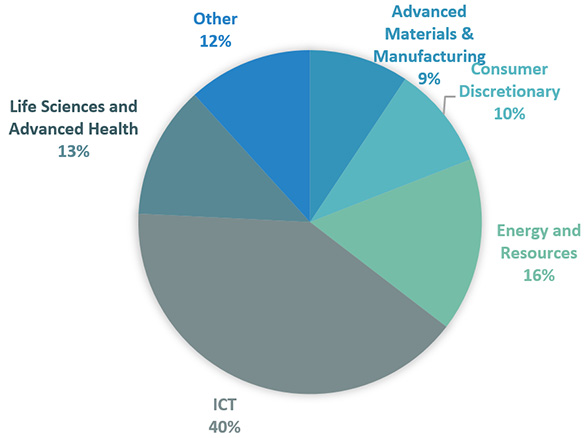
Chart 2: Age distribution of supported firms versus the benchmark population
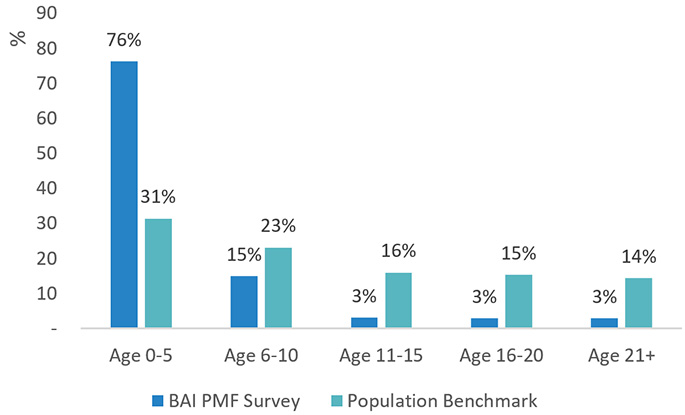
Firm Growth Rates
An analysis of employment growth in the two populations found that BAI companies were significantly more likely than the benchmark to have increased employment and achieved high-growth status for employment over both one and three year periods (chart 3). 19% of firms in the sample of BAI-supported companies would classify high-growth companies based on the standardized definition, compared to only 1.5% of firms in the benchmark population. That means for companies with less than 10 employees, they added 8 or more employees over a rolling three-year term. For companies with more than 10 employees, the growth rate achieved 72% over a three year period. An additional 45% of the BAI companies witnessed one year of employment growth but did not meet the stricter definition of high-growth firms. Taken together, this indicates that 64% of BAI companies were experiencing some level of growth over either a one or three year period.Footnote 1
Chart 3: Employment growth of supported firms versus the benchmark population
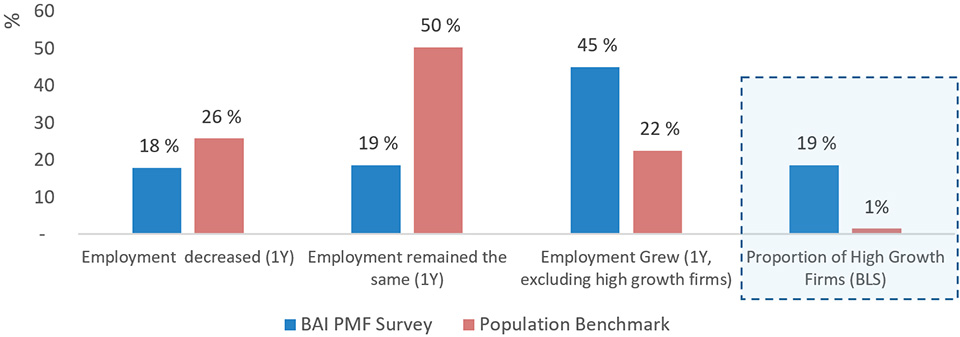
Chart 4: Revenue growth of supported firms versus the benchmark population
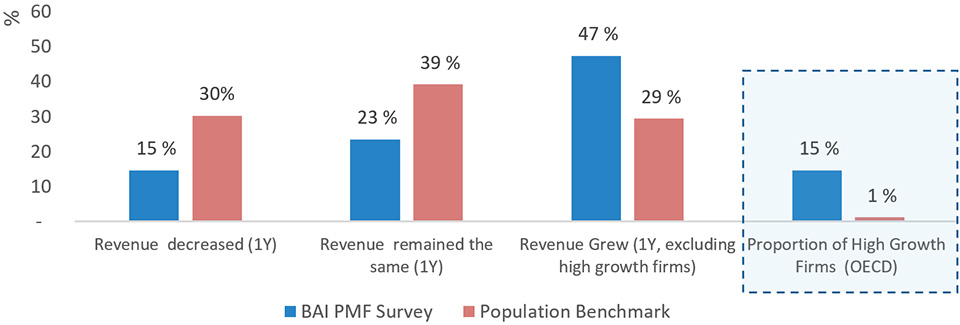
As depicted above, a similar pattern emerges in the analysis of revenue growth. On this metric, 15% of BAI companies met the Organization and Economic Cooperation and Development (OECD) definition for high growth firms, meaning they have achieved at least 20% annualized revenue growth over a period of three years. An additional 47% of BAI-supported companies did not meet the strict definition for high-growth firms, but nevertheless experienced some revenue growth (>10%) over a one year period. As with employment, a significantly higher share of the BAI companies were classified as either high growth firms or as firms experiencing one year of revenue growth, relative to the population benchmark group.
Data on year-over-year growth rates remain exploratory at this stage. In particular, it is worth noting that high growth rates experienced by BAI companies when compared to the benchmark group could be associated with a range of factors not controlled for in this analysis – such as firm age and sector. Future analysis will establish a more rigorous control group for comparison. Nevertheless, the analysis does provide a preliminary profile of BAI firms, indicating that a significant percentage of these companies are experiencing some degree of employment and/or revenue growth.
Engagement with Government Programs
To better understand how and to what degree BAI companies interact with federal government innovation programs, BAI PMF data was linked with data collected through the Horizontal Business Innovation and Clean Technology Review. Data from the Horizontal Review includes program data provided by 22 federal government departments and crown corporations. However, crown corporations – such as the Business Development Bank of Canada and Export Development Canada – were not included as part of the BAI company data analysis.
The analysis found that 50% of BAI companies had engaged with some form of federal government innovation programming, significantly more than the population benchmark group (2%). With respect to program interactions – defined as an individual instances in which a firm received government program support – the most frequent occurred with the National Research Council of Canada (70%), followed by the federal regional development agencies (12%) the National Sciences and Engineering Research Council (8%) and Global Affairs Canada (6%).Footnote 2
BAI impact and Net Promoter analysis
Finally, an analysis of client satisfaction among BAI-supported companies presents a considerably positive view of the role these support organizations are playing in helping their clients create viable companies. Client companies were asked to rate the impact of BAI services on their chances of success and to characterize how likely they are to recommend the BAI's services to others. The results suggest that 76% of client companies think that the BAI program they participated in had either a 'significant' or 'vital' impact on their chances of success (chart 5) and that 66% of BAI client companies can be classified as promoters, meaning that they are highly likely to recommend the BAI program to others (chart 6).
Chart 5: What impact has this BAI had on your chances of success?
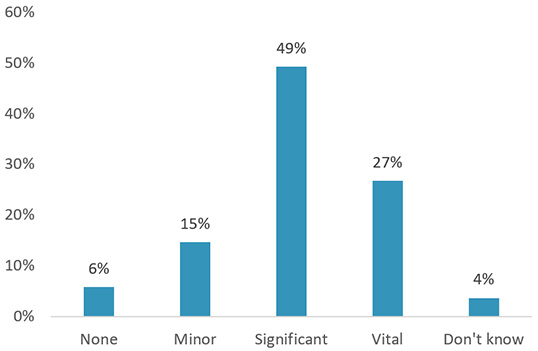
Chart 6: How likely are you to recommend this BAI to others?
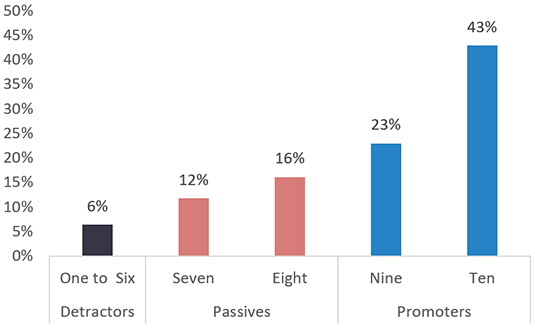
Key Conclusions and Future Potential
It is important to bear in mind that the observations and descriptive statistics above are drawn from a relatively small pool of companies (522 in total) and roughly 10% of BAIs in Canada (or 20 out of an estimated 220+ BAIs operating in Canada). Nevertheless, the analysis of the pilot data highlights some interesting preliminary findings. Among others, these include that:
- BAIs are working with young, technology-focused companies.
- BAI companies are significantly more likely to be growing in employment and revenue and to be achieving high growth, companies to the benchmark group.
- 76% of company respondents describe their BAI program as being either 'significant' or 'vital' to their success.
- A majority of respondents indicated they would be likely to recommend their BAI program to others.
Going forward, the ability to collect data on a larger number of supported companies linked to a larger number of BAIs, and to track the same population of firms over time, will yield richer insights into Canada's startup ecosystem. For example, it will be possible to track the growth and survival rates of companies over time. The ability to segment the sample by sector, region and BAI program types (among other variables) will permit analysis of growth trajectories for different types of firms and different types of BAI supports. A larger dataset will present opportunities to compare the population of BAI-supported companies to various control groups on the broader population of Canadian SMEs. It will also be possible to link the dataset on BAI-supported firms to additional administrative datasets and third party databases, including those focused on venture capital (VC) and angel investment.
